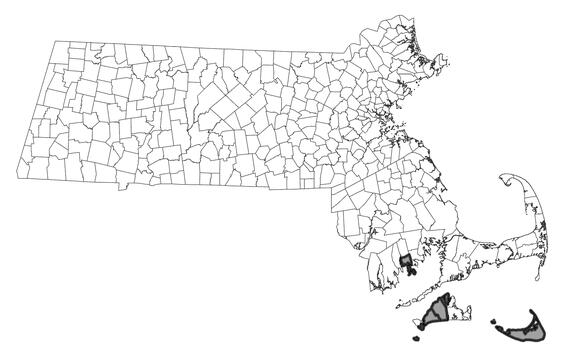- Scientific name: Tipularia discolor
- Species of Greatest Conservation Need (MA State Wildlife Action Plan)
- Endangered (MA Endangered Species Act)
Description
Cranefly orchid is a perennial herb in the orchid family (Orchidaceae) which produces a single basal leaf and a slender flower stalk. The solitary leaf is dark green and, often, purple-spotted above, dark purple beneath, ovate, and measures 8-10 cm x 6-7 cm (3.1-4 in x 2.4-2.8 in). However, in Massachusetts, leaves are usually smaller, mostly 2.5-3.8 cm (1-1.5 in) long. The leaf is erect at first but soon lies more or less flat on the leaf litter. Cranefly orchid's inflorescence is slender, erect, and forms a 10-20 cm (4-8 in) long, loose raceme (an unbranched, elongate grouping of stalked flowers) with 20 to 40 tiny blossoms (often fewer in Massachusetts). Sepals and petals are a pale brownish-greenish color with purple veins, measure 4-8 mm x 1.5-3 mm (0.16-0.32 in x 0.06-0.12 in), and are arranged asymmetrically, with one petal overlapping the dorsal sepal. The pale purple lip (lowermost petal) is three-lobed with a 1.5-2 cm (0.6-0.8 in) long horizontal spur at the base. The flowers are horizontal to somewhat drooping. Each plant produces round tubers below ground which split off to produce new plants. Cranefly orchid thus often grows in clusters that originated from a single plant. The growth pattern of cranefly orchid differs from that of most flowering plants in that its leaf appears in fall, winters over, photosynthesizes (unless snow-covered), provides food for the tubers, and dies back in the late spring. There is a brief period of a few weeks, from late May-June, when nothing is visible above ground. The scape then emerges in mid-June in the north (or September in Florida). The plant subsequently develops buds, comes into flower in mid-July, puts out fruit and dies within a period of 2-3 months. The best time to look for cranefly orchid is in the fall.
Within its range in New England, there is no other similar orchid. Puttyroot (Aplectrum hyemale) has similar biology, but its basal leaf is long-elliptical, pleated lengthwise, and devoid of purple color. Canada mayflower (Maianthemum canadense), a common woodland plant in the Lily family, has a single, medium green basal leaf when immature, but this leaf has no purple coloring.
Life cycle and behavior
This is a perennial species.

Population status
Cranefly orchid is currently listed as endangered in Massachusetts. Massachusetts Natural Heritage & Endangered Species Program database has 20 records from 4 counties: Dukes, Barnstable, Nantucket, and Bristol. Twelve of those records are within the last 25-year period. The plant is also considered rare in Illinois, Michigan, Missouri, New York, New Jersey, Pennsylvania, and Oklahoma. Reasons for the plant's rarity in Massachusetts include the fact that it is at the northeastern limit of its range here. Also, excessively wet weather on Martha's Vineyard in the past may have created problems for the plant.
Distribution and abundance
The documented range of cranefly orchid extends from southeastern Massachusetts and Long Island, New York, to southern Indiana, south to Florida, and eastern Texas. Massachusetts is the only New England state where this species occurs.

Distribution in Massachusetts. 1999-2024. Based on records in the Natural Heritage Database.
Habitat
Healthy habitats are vital for supporting native wildlife and plants. Explore habitats and learn about conservation and restoration in Massachusetts.
Threats
Threats in Massachusetts include encroaching developments, a possible road-widening plan, and, possibly, browsing by over-abundant deer.
Contact
| Date published: | May 7, 2025 |
|---|